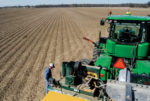Advertise Follow Us
Articles Tagged with ''Operational benchmark study''
Strip-Till Operational Benchmark Study
Increased adoption of cover crops and variable-rate fertilizing help strip-tillers maintain corn yields and increase soybean yields in 2015.
Read More
2nd Strip-Till Operational Benchmark Study: Cover Crop Use Spreads for Strip-Tillers
Strip-till corn populations remain consistent, while soybean seeding rates decline and use of twin-row systems increases.
Read More
2nd Strip-Till Operational Benchmark Study: Sidedressing Nitrogen, Use of Variable-Rate Fertilization on the Rise
Banded placement of P and K below the berm and use of RTK-level accuracy remain cornerstones of successful strip-till operations.
Read More
2nd Strip-Till Operational Benchmark Study: Acreage and Yields Increase for Strip-Tilled Corn and Soybeans
Farmers grew their total percentage of farm acres and average number of acres per farm being strip-tilled in 2014.
Read More
2nd Strip-Till Operational Benchmark Study: Improving Strip-Till Production with Precision Technology and Cover Crops
Ongoing adoption of cutting-edge practices and conservation-minded methods help boost strip-tilled corn and soybean yields.
Read More
Cut, Chop, Smooth, Mix: Vertical Tillage Seeks No-Till Role
Some no-tillers and strip-tillers say vertical-tillage tools are helping them size and incorporate residue, prepare seedbeds, reduce weed pressure and improve planting conditions without trashing no-till.
Read More








